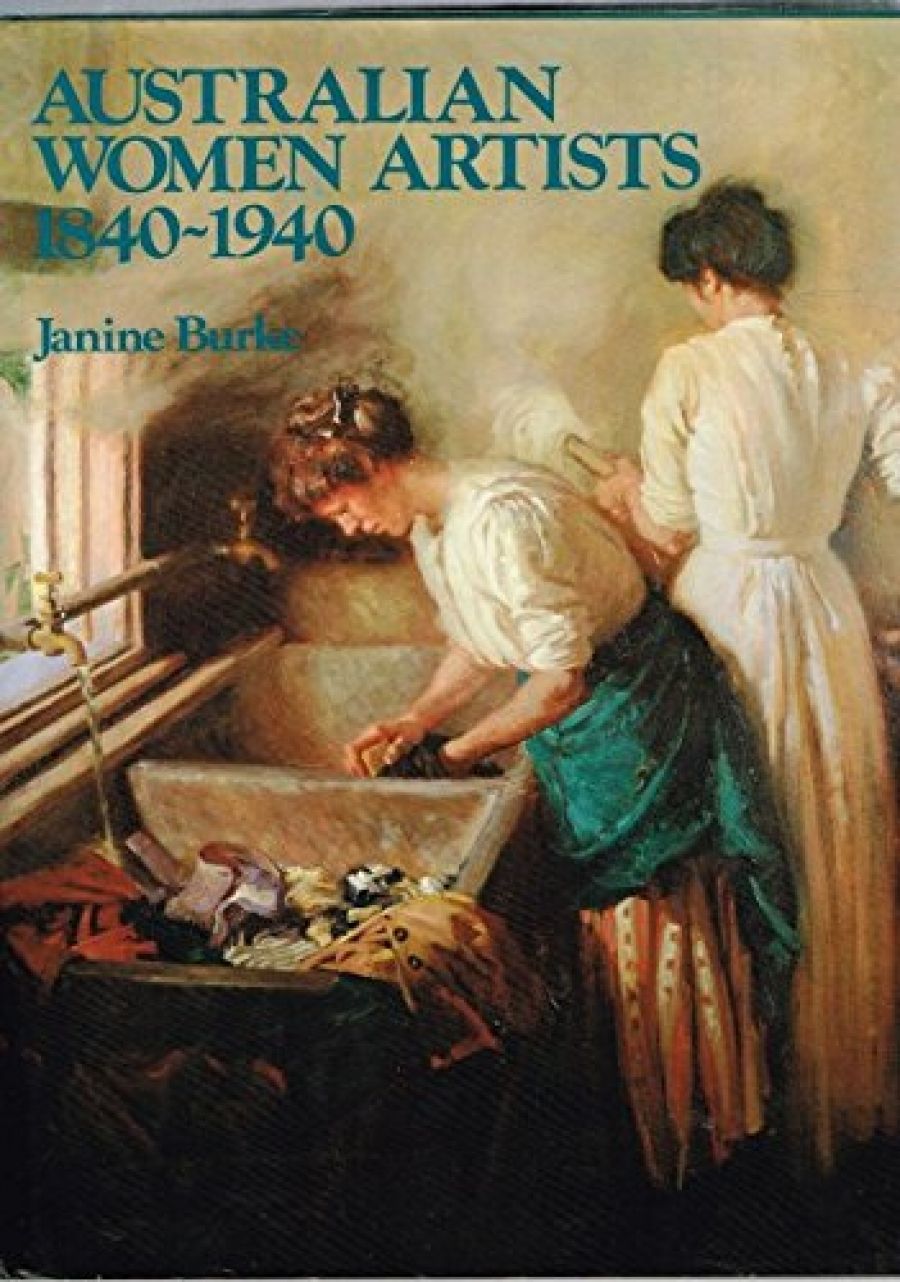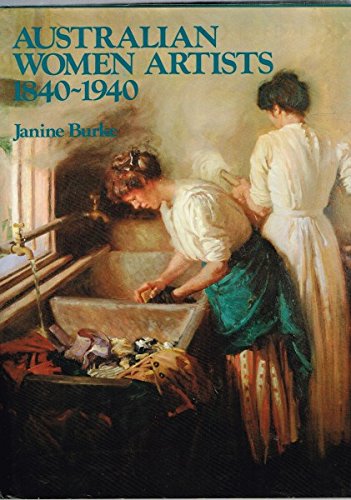
- Free Article: No
- Contents Category: Art
- Review Article: Yes
- Article Title: Women Artists Stand on Their Own
- Online Only: No
- Custom Highlight Text:
Janine Burke’s Australian Women Artists, 1840–1940 is a memento of the exhibition of women’s art initiated by the Ewing Gallery for 1975, International Women’s Year. An extraordinarily rich exhibition, it convinced me and many others who saw it on its tour of the eastern states, that Australian women painters, for at least the first 30 years of this century, must share the laurels equally with men.
- Book 1 Title: Australian Women Artists 1840–1940
- Book 1 Biblio: Greenhouse Publications, 188pp
- Book 1 Cover Small (400 x 600):

Appropriately, the picture which dominated the exhibition by its size and subject was Vida Lahey’s painting of women in the wash house. One woman huddles over the concrete troughs, while the other, her back turned, lifts things from the copper with a wooden pole. The author tells us how Vida strapped her canvas to the mangle, and worked close to her models in the steam and smells of the laundry. The picture is on the cover of the book.
Janine Burke is not the first to acknowledge the importance of women in Australian art. William Moore gave them a prominent place in his history published in the 1930s, and Bernard Smith noted the preeminence of women in the period immediately after World War I. Janine took this claim and built the exhibition largely around the first three decades of this century, and looking back to the 1880s as the beginning of professionalism for women artists. (She doesn’t say so, but the 1880s were also the beginning of professionalism for men. Women were not out of step in this respect.) Increasing their numerical representation from the 1880s onward, women early this century equalled or outnumbered men in societies such as the Victorian Artists Society. At the National Gallery Schọol women consistently outnumbered men, sometimes by as many as 5 to 1. After Constance Jenkins won the N.G.V.’s prestigious Travelling Scholarship in 1908, successive women took the scholarship for a period lasting 27 years.
Statistics have given the author grounds for arguing that women have had a better go in Australia than their contemporaries elsewhere in the world. She writes:
The output of talented and sometimes prominent women artists working during this time and particularly in the 1920s and 30s, far outstrips the contribution of their contemporaries in either Europe or America. Women’s art emerges as Australia’s special province in the course of 20th century art.
An interesting claim, worth arguing out, yet we are not given sustained overseas comparisons or any guess as to why Australia has the honours. For what it is worth, women artists in Europe and the U.S. also bettered their position in relation to men in the same period, though they never reached the leading position women in Sydney attained in the 1920s. My guess is that it was easier for women to gain positions where they dispensed power in a small community, which was still, as yet, relatively undifferentiated institutionally, than it would be in much larger, more established centres, where the various functions of art and modes of communicating with the public were clearly differentiated.
Women artists in Sydney in the 1920s were known as social leaders, fashion and design advisers, as well as painters. Modern music, literature, architecture, theatre, decor, etc., were recognised, at the time, as aspects of a single broad new taste wave. Men were bogged down making portraits of men wearing war medals, they were hamstrung by a sense of representing a new young nation which had to prove itself in the grownup world. They wanted dignity and dash and bravura in their art, and sought out gum trees, work horses, men of the soil, and gallant young Anzacs, as a form of national expression. As a broad generalisation, this split between Modernism and Nationalism is the reason women took the artistic lead after the World War I.
It is a pity the author doesn’t explore the connection with fashion until she has stopped writing about the 1920s and is trying to account for why things went wrong for women from the mid-1930s. With the ebbing of women’s fortunes she apparently feels able to recognise how fashionable was Sydney-type Modernism.
I suspect she felt it would be down-grading women’s contribution to art in the 1920s if she put Modernism into a taste context. Overall she carefully avoids criticising women, and perhaps shares or feels unable to combat, the derogatory overtones fashion has in traditional art history. So she hedges her bets and won’t steer into trouble. Her guiding principle has been to be supportive. And that marks the difference between this new edition and the original catalogue. The 1975 exhibition was launched in a mood of excitement and discovery. Janine was then prepared to make bold statements about recurring imagery in women’s art, and the unique female sensibility this implied – and attacked art history as it had been written. The mood of her rewriting is less aggressive, she stays close to personalities and particular works of art, as if wishing to avoid larger generalisations or a more comprehensive sense of women’s history; and somehow – though I could be judging wrongly – her effort seems just that little bit less ambitious. It has a contained, cocooned feeling, as if women’s art exists as a thing of its own, outside and apart from art in general. Running through it all is this thread of support: which, I feel, is unfair to art that does not need coddling. Now that women’s art has been brought into focus, and shown to compare well with men’s art, there is no need to treat it with kid gloves. That point was proved five years ago.
The book opens with the claim that it is ‘the first history of Australian women artists’, but we have to exempt it from being history. It is what it set out to be: a remake of the original catalogue. Six artists and 16 reproductions have been added, the biographical outlines corrected, Margel Hinder’s and Noel Sheridan’s essays have been dropped, and the charming reminiscences of Grace Crowley retained. The author expanded her original 7,500 word essay to 22,000 words.
She has added photographs of some of the artists. There is one of Thea Proctor in ruffled fancy dress and carrying a parasol – just like one of her prints! Another photo shows Thea, the only woman in the Sydney Society of Artists selection panel in 1922. Again she is extremely well dressed; and we get the message from the men’s sober business suits and ties that the bohemianism of the 1890s, and Edwardian dandyism, were out of favour for male artists in the 1920s.
Hilda Rix Nicholas, smart and positive-looking, paints before an interested audience on Bondi Beach in a photo taken in 1927. There is a portrait-style photograph of an introspective Joy Hester (c.1947) – one of the artists added since 1975. Four reproductions of Joy’s wash drawings have the vital, extremely close and passionate feeling which is so much a part of her work. One of them is a late self-portrait, raggedly brushed and emotionally raw, especially by contrast to the reserved, remote quality of her face in the photograph.
The photographs go well with the biographical content of the book. Furthermore they are a splendid foil to women’s portraits of women.
According to Germaine Greer, who recently published The Obstacle Race (a history of European women’s painting through the centuries), the ‘obstacle of self-consciousness’ is one aspect of the crippled female psyche which prevents women still, from running the artistic race on an equal footing with men. Janine Burke, thank God, has a more positive attitude.
She has no trouble showing how some of Germaine’s ‘obstacles’ have, at times, been favorable to women artists. Germaine Greer argues that women have been smothered by the demands of love and family. Janine Burke shows how Adelaide Ironside’s mother supported her; and Jane Sutherland, Ellis Rowan, Norah Simpson, Grace Cossington Smith and Margaret Preston are other middle-class women who benefited from and were not suppressed by their families.
Women’s narrow domestic environment within the home, which Germaine Greer regards as a cramping, confining prison as it is for many women provides the glowing interior world of a painter like Grace Cossington Smith. The best painter of her generation without a doubt, Cossington Smith’s achievement was at its peak when she narrowed her attention to her home, its garden, and finally, in her best works, she was painting her bedroom, or just a corner of it. Limiting her drawing to a few broad architectural planes, she filled the canvas with palpitating light, incandescent yellows and greens. Here is an instance where sex-roles may conceivably work against men. If Grace Cossington Smith were a man, would she have been offered the opportunity to stay at home, painting when and as she liked, without much thought of making a name for herself, but free to make what she wanted of art?


Comments powered by CComment